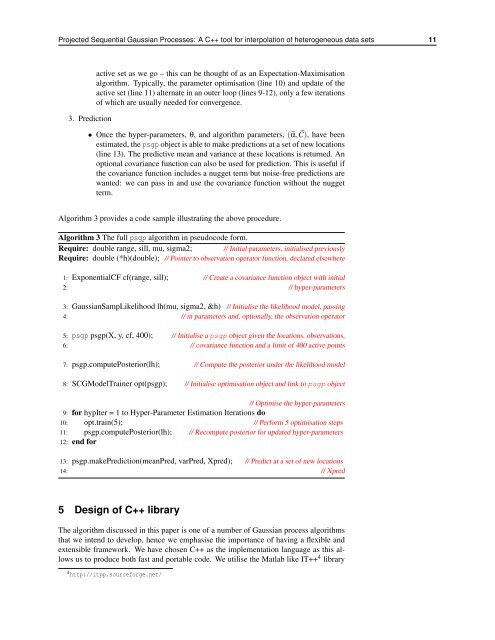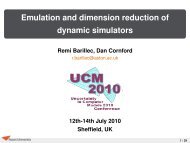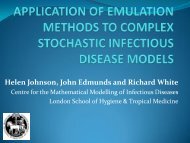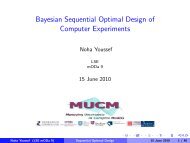Projected Sequential Gaussian Processes: A C++ tool for ... - MUCM
Projected Sequential Gaussian Processes: A C++ tool for ... - MUCM
Projected Sequential Gaussian Processes: A C++ tool for ... - MUCM
You also want an ePaper? Increase the reach of your titles
YUMPU automatically turns print PDFs into web optimized ePapers that Google loves.
<strong>Projected</strong> <strong>Sequential</strong> <strong>Gaussian</strong> <strong>Processes</strong>: A <strong>C++</strong> <strong>tool</strong> <strong>for</strong> interpolation of heterogeneous data sets 11<br />
3. Prediction<br />
active set as we go – this can be thought of as an Expectation-Maximisation<br />
algorithm. Typically, the parameter optimisation (line 10) and update of the<br />
active set (line 11) alternate in an outer loop (lines 9-12), only a few iterations<br />
of which are usually needed <strong>for</strong> convergence.<br />
• Once the hyper-parameters, θ, and algorithm parameters, (α,C), have been<br />
estimated, the psgp object is able to make predictions at a set of new locations<br />
(line 13). The predictive mean and variance at these locations is returned. An<br />
optional covariance function can also be used <strong>for</strong> prediction. This is useful if<br />
the covariance function includes a nugget term but noise-free predictions are<br />
wanted: we can pass in and use the covariance function without the nugget<br />
term.<br />
Algorithm 3 provides a code sample illustrating the above procedure.<br />
Algorithm 3 The full psgp algorithm in pseudocode <strong>for</strong>m.<br />
Require: double range, sill, mu, sigma2; // Initial parameters, initialised previously<br />
Require: double (*h)(double); // Pointer to observation operator function, declared elsewhere<br />
1: ExponentialCF cf(range, sill); // Create a covariance function object with initial<br />
2: // hyper-parameters<br />
3: <strong>Gaussian</strong>SampLikelihood lh(mu, sigma2, &h) // Initialise the likelihood model, passing<br />
4: // in parameters and, optionally, the observation operator<br />
5: psgp psgp(X, y, cf, 400); // Initialise a psgp object given the locations, observations,<br />
6: // covariance function and a limit of 400 active points<br />
7: psgp.computePosterior(lh); // Compute the posterior under the likelihood model<br />
8: SCGModelTrainer opt(psgp); // Initialise optimisation object and link to psgp object<br />
// Optimise the hyper-parameters<br />
9: <strong>for</strong> hypIter = 1 to Hyper-Parameter Estimation Iterations do<br />
10: opt.train(5); // Per<strong>for</strong>m 5 optimisation steps<br />
11: psgp.computePosterior(lh); // Recompute posterior <strong>for</strong> updated hyper-parameters<br />
12: end <strong>for</strong><br />
13: psgp.makePrediction(meanPred, varPred, Xpred); // Predict at a set of new locations<br />
14: // Xpred<br />
5 Design of <strong>C++</strong> library<br />
The algorithm discussed in this paper is one of a number of <strong>Gaussian</strong> process algorithms<br />
that we intend to develop, hence we emphasise the importance of having a flexible and<br />
extensible framework. We have chosen <strong>C++</strong> as the implementation language as this allows<br />
us to produce both fast and portable code. We utilise the Matlab like IT++ 4 library<br />
4 http://itpp.source<strong>for</strong>ge.net/






